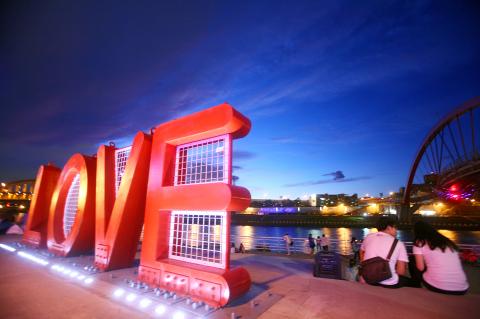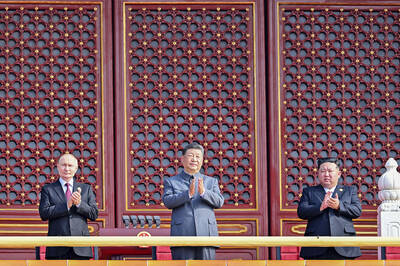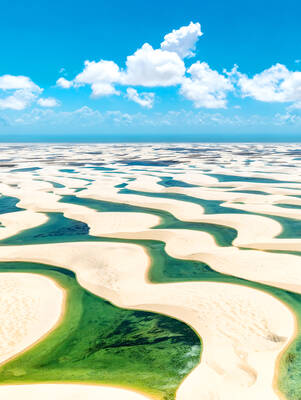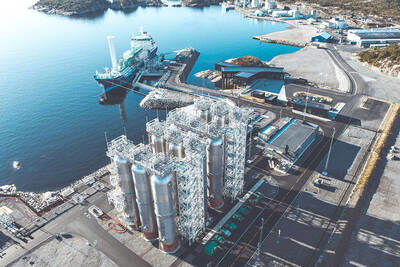The Rainbow Bridge is located in Taipei’s Songshan District. Similar to the Crescent Bridge, the bridge is for pedestrians and bikers only. With its unique S-shape, when viewed at night from beneath after the lights are lit, the bridge resembles a flying dragon suspended in mid-air, for all to see in its full magnificence. Many people buy snacks from the nearby Raohe Street Night Market, then make their way to the nearby Rainbow Riverside Park or Chengmei Riverside Park, where they can take a stroll, enjoy the view and eat great food.
(Liberty Times, translated by Ethan Zhan)

Photo: Liu Jung, Liberty Times
照片:自由時報記者劉榮攝
彩虹橋位於台北市松山區,與新月橋一樣是行人與自行車專用的橋樑,橋身呈現特殊的S形;晚上點燈後從橋底望去,儼然就是條盤旋在空中的飛龍,氣勢十足。由於彩虹橋所在之處就在饒河夜市附近,不少人都會買些夜市美食到橋邊的彩虹河濱公園或成美河濱公園散步;邊賞美景邊吃美食,堪稱人生一大樂事。
〔自由時報綜合報導〕

China commemorated 80 years since the end of World War II last week with a massive military parade against a backdrop of a disputed history about who ultimately defeated Japan. The issues, including Japan’s reckoning with its wartime record in China, are bound to flare again in December, a flashpoint anniversary of the mass killing in Nanjing by invading Japanese troops. Below is an explainer about what the different — and disputed — points of view are. WHAT IS CHINA’S VIEW? For the Chinese government sitting in Beijing, this is a clear-cut issue: China sacrificed 35 million people in a heroic and brutal struggle

Rarely does Nature present such a striking contradiction as the one found in Lencois Maranhenses National Park. Located along Brazil’s northeastern coast, the park unveils breathtaking scenery, where rippling sands meet crystal-clear lagoons. Under the sun’s golden glow, the waters glitter in shades of turquoise and emerald. So surreal is this spectacle that visitors might wonder if they’re gazing at a digitally modified photo rather than a living landscape. Were it not for the unique geographical and climatic conditions, such a marvel would not exist. Unlike typical deserts, Lencois Maranhenses receives a substantial amount of rainfall, particularly during the rainy season

In a major step to combat carbon emissions, Norway’s pioneering “Northern Lights project” is set to expand its carbon capture and storage (CCS) capabilities. Backed by energy giants and the Norwegian government, this collaborative project is working to increase its annual carbon storage capacity from 1.5 million to over five million tons. Northern Lights focuses on capturing CO2 emissions from industrial sources across Europe and securely storing them underground. Captured CO2 will be liquefied and transported by ship to the storage facility located off the coast of Norway. It will be injected through pipes into geological formations about 2,600m below the

1. 我和他相識已經九個月了。 ˇ He and I have known each other for nine months. χ I and he have known each other for nine months. 註:單數的不同人稱代名詞連用,其次序一般是 you and I、you and he、he and I、she and I。複數人稱代名詞的次序是 we and you、you and they、we, you, and they。 2. 我自己不願意去那家公司工作。 ˇ I myself am unwilling to work in that company. χ Myself am unwilling to work in that company. 註:myself、yourself、himself、herself、itself、ourselves、yourselves、themselves、oneself 等反身代名詞可用來加強語氣,但必須跟在其所加強的人之後,不能單獨出現當作代名詞用。 I myself went there. I’ll do it myself. He did it himself. 3. 沒有人知道這件事情。 ˇ Nobody knows about this. χ No body knows about this. 註:nobody 不可寫作 no body;同樣 anybody、somebody、everybody 都不可以分開來寫。說「沒有人」,用 no one 或 none 都可以。 4. 我會把自己的書送給他。 ˇ I will give my own book to him. χ I